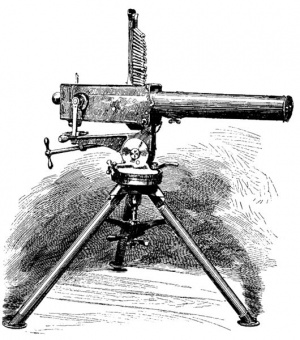Gardner gun
| |||||||||||||||||||||||||||||||||||||||||||||||||
The Gardner gun was an early type of machine gun. It had one or two barrels, was fed from a vertical magazine or hopper and was operated by a crank. When the crank was turned, a feed arm positioned a cartridge in the breech, the bolt closed and the weapon fired. Turning the crank further opened the breechblock and extracted the spent round.
Contents[hide] |
Development
The Gardner machine gun was invented in 1874 by William Gardner of Toledo, Ohio formerly a Captain in the Union army during the American Civil War. After producing a prototype he went to the Pratt and Whitney company, who after a year of development produced a military version of the weapon.
A demonstration to officers at the United States Navy yard in 1875 was successful, however they recommended that Pratt and Whitney continue with development of the system, incorporating improvements to the feed system, which were designed by E.G. Parkhurst, an engineer at Pratt and Whitney. The army attended the tests, but showed no interest in the weapon.
Parkhurst added many improvements to the gun's firing mechanism which made it more reliable. During 1877 additional tests took place with a .45 calibre (11.4 mm) version of the weapon, which determined its muzzle velocity to be 1,280 feet per second (390 m/s).
On 17 June 1879 a further demonstration was carried out at the Navy Yard, during which the weapon was presented by Francis A. Pratt and Amos Whitney. The weapon fired a total of 10,000 rounds during the test, taking a total elapsed time of 27 minutes 36 seconds, with breaks between firing to resolve an issue with one of the extractors. While the test was not without issues the weapon managed to fire 4,722 rounds before the first stoppage [2], and after the stoppage was resolved it fired approximately 5,000 rounds without incident.
On 15 January and 17 March 1880 duplicate tests were conducted at Sandy Hook Proving ground in front of an Army review board. The weapon performed well, and they recommended that the Army buy a limited number for field evaluation, noting the low cost of the weapon. However the Army declined to purchase.
At this point, the British Royal Navy, which had successfully deployed the Gatling gun became interested in the weapon, and Gardner was invited to England to exhibit his weapon. The British Admiralty were so impressed by the demonstrations that they adopted the weapon and purchased the rights to produce the weapon in England. Gardner would remain in England to supervise the construction of the weapons.
The British Army then took an interest in machine guns and after a series of trials selected the Gardner gun. During these tests a five-barrelled Gardner gun fired 16,754 rounds before a failure occurred, with only 24 stoppages. When operator-induced errors were taken into account, there were only 4 malfunctions in 10,000 rounds fired. The Army adopted the weapon, although its introduction was delayed because of opposition from the Royal Artillery.
There was also the .577/450 Martini-Henry calibre Bira gun, similar to the Gardner gun but with a single barrel and designed in Nepal.
Resources
While there are no existent manuals remaining for the Gardner gun (that we know of, anyway), we have managed to track down some images that give some better ideas of the weapon's workings:
Notes
- ↑ " . . Having thus satisfied ourselves that we had a good weapon in our hands, we set to work to equip a battery of four guns.....The favorite tactics of the dakoits is to lay in ambush in dense jungle, where they are at home and conparatively safe; they then fire a volley into our unsuspecting troops and depart. When the dakoits oppose our advance by clinging to the jungle in front, their position, never extensive, would be quickly searched out by our machine guns. Again, their value would be appreciated in storming stockades some of which are bullet-proof, and some are not. In The latter case the guns, having a range of two thousand yards, would keep up a stream of bullets out of the enemy's reach. . . . In like manner they would be utilized in the attack on dakoit villages.... Moreover, the power of these guns for counter-attack as well as for passive defense cannot fail to be recognized."
-- Taken from the report of Captain Lloyd, R. A., commanding a battery of four Gardner guns in the Third Burmese War. - ↑ An initial warmup burst of 200, followed by 1,000 rounds, followed by 431 rounds, followed by 3,071 rounds.
References
- George M. Chinn, The Machine Gun. History, Evolution, and Development of Manual, Automatic, and Airborne Repeating Weapons, Volume I.






